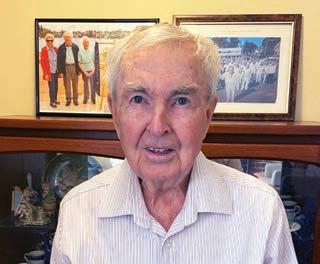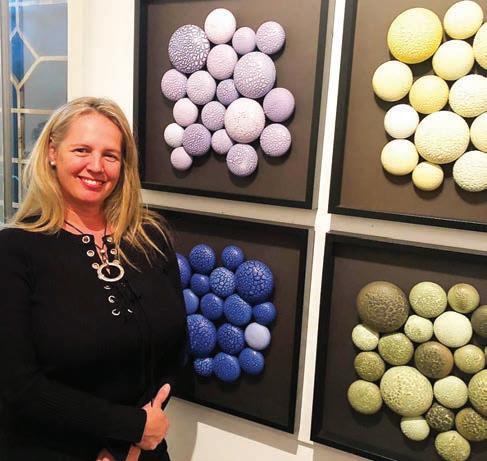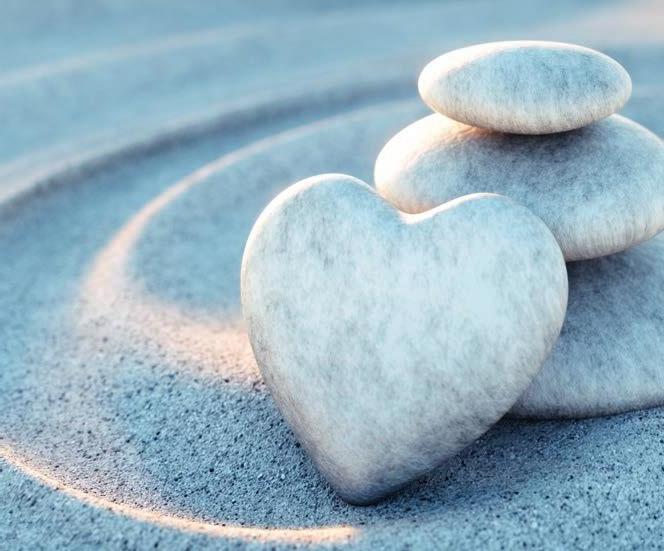
5 minute read
A local way to interpret a national conversation
Last year’s bushfires took their toll in every conceivable way, and it is only now, after the skies cleared enough for everyone to breathe, that pressure is mounting from all corners about how to best manage the future of Australian landcare. Gallery Lane Cove is opening its space to three First Nations women artists, during what will also be NAIDOC Week, to encourage a constructive and inclusive dialogue about this crucial topic.
WORDS: NICOLA RICHES (Photo above - Warrior by Barbara McGray
Advertisement
Dyarra Murrama Guwing (The Sun Setting Red),” is a timely art show that focuses on the important conversation around landcare, the natural environment and climate change from a matrilineal First Nations perspective. The exhibition is something of a coup for Gallery Lane Cove, which has secured site-specific work from three artists including world-renowned photographer Barbara McGrady. Cited as the “the first Aboriginal female photojournalist of her calibre”, McGrady’s photographs span 30 years. Working as a Gomeroi/Gamilaraay Murri yinah (woman), she is known for documenting the lives of First Nation peoples in urban areas and uses her medium as an influential tool for empowerment and social change.
The brainchild of Gallery Lane Cove curator Rachael Kiang, “Dyarra Murrama Guwing (The Sun Setting Red),” is a response to last summer’s devastating bushfires. Time has afforded artists the opportunity to process the fires, and a conversation around last summer is coming to the fore in all walks of life. Lane Cove is one of those havens where the gallery and community are open to challenging how landcare is undertaken, and how the knowledge of Australia’s First Nations has the power to regenerate and steer policy.
“First Nation communities have a very intimate knowledge of the land thanks to their holistic association with nature and there is much that we can learn from them,” explains Rachael, who is keen to show “women artists’ points of views, their stories and experiences in this area.”
She acknowledges how important it was for the gallery, particularly for the purposes of this show, to engage in cultural consultation. As a result, Gallery Lane Cove partnered with curator and Malera Bandjalan, Mitakoodi woman Kyra Kum-Sing. Kyra splits her time between her home in Bandjalan country in north New South Wales and Sydney where, among many things, she works for the Boomalli Aboriginal Artists Co-operative.
She explains why it was essential that this exhibition focused on the matrilineal perspective; “There is men’s business and there is women’s business. There is oral knowledge that is passed down from woman to woman, and having come from a strong matrilineal line myself, I know how vital it is for this to be maintained. Everything wedo, whether it is creating, dancing, taking part in ceremonies, is part of our holistic caretaking of our culture and our land. We are the land.”
Dyarra Murrama Guwing (The Sun Setting Red) sees McGrady’s work paired with works by Nadeena Dixon and Carmen Glynn-Braun, who is the youngest of the three. Nadeena, a Wiradjuri, Yuin and Gadigal (Dharug-Boorongberigal clan) woman, brings to the table rich knowledge and incredible talent as a master weaver in the First Nations tradition, a multidisciplinary contemporary artist working in animation, video and photography, plus work as a teacher at UTS.

Gadigal Fisherwoman - Nadeena Dixon 2020
“A lot of my practice is based on country,” Nadeena says. “It uses materials and gathering techniques that our people have maintained for thousands of years. I find so much strength and beauty in being able to observe reverence and be present when walking this spiritual path as an artist and a teacher,” she explains. Like McGrady, Nadeena too has created new works for this specific show.
Understanding how spirituality, from a female perspective, plays into the heart of this show’s message will undoubtedly spark a dialogue with the audience. Kyra explains, “As traditional custodians, the Aboriginal people have much to impart and share in terms of how we relate to nature, flora and fauna. The Aboriginal female perspective and insights to environmental care highlight how we can realign our relationship with nature and begin the process of healing and renewal.”
The female scaffold underpinning “Dyarra Murrama Guwing (The Sun Setting Red),” is rooted in the First Nations womens experience of living in a society that often privileges the male view. Carmen Glynn-Braun, an emerging Australian artist stemming from the Southern Arrernte, Kaytetye, and Ammatyerre nations across Central Australia, explains how shows like this attempt to open challenging conversations such as the ongoing privilege of the male view.
“As an artist who unpacks a lot of heavy political content within my work, I find art is one of the only safe spaces for people of colour to explore these themes freely,” she says. “Art for me is about truth telling and offering a translucent extension of myself and my experiences in the world,” says Carmen. Like Nadeena, Carmen is a multidisciplinary artist. Fascinatingly, her work for Gallery Lane Cove is devised as a response to Barbara’s and Nadeena’s.

'Solid Foundations' - Carmen Glynn Braun 2020
Guardian Australia’s Indigenous affairs editor Lorena Allam wrote in January of this year: “It’s a particular grief, to lose forever what connects you to a place in the landscape. Our ancestors felt it, our elders felt it, and now we are feeling it all over again as we watch how the mistreatment and neglect of our land and waters for generations, and the pig-headed foolishness of coal-obsessed climate change denialists turn everything and everyone to ash."
Carmen is quite clear about what needs to change: “This (the fires) obviously could have been prevented. Indigenous land preservation methods absolutely could have been utilised here. Skilled burning methods preventing bush fires have been carried out by First Nations Peoples for thousands of years, from all over Australia. And many different types of country from salt water to desert. I carry some sadness that this is only being heavily investigated now - after such a catastrophic event. Our knowledge should be considered as expertise always, and my hope is that we are to maintain it from here.”
Dyarra Murrama Guwing (The Sun Setting Red) takes place at Gallery Lane Cove 4 November - 5 December 2020.
A panel discussion with the artists and curators takes place 14 November at 11am. The exhibition is supported by Lane Cove Council and URM Group.





